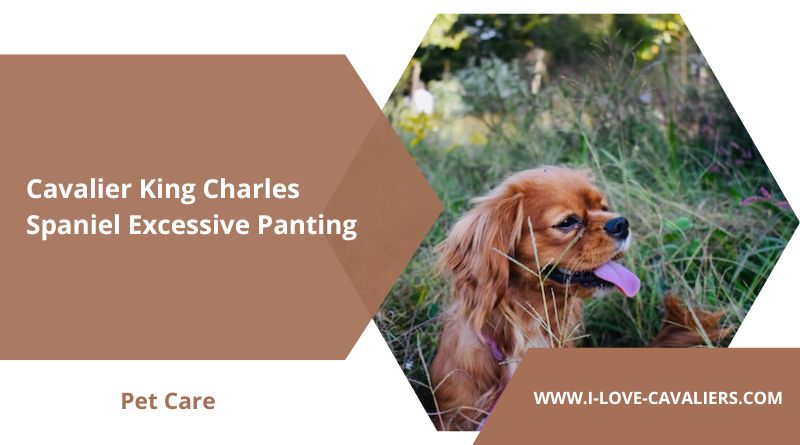Have you ever watched your dog panting away and wondered, “Is my Cavalier merely sweating, or is there something more to this huffing and puffing?”
We all know that dogs pant; it’s kind of their thing. However, at times, this heavy panting can lead us to question its normalcy.
In this article, I will discuss excessive panting in Cavalier King Charles Spaniels and share my experience regarding when this behavior is normal and when it becomes a cause for concern.
What is a Normal Resting Breathing Rate for Cavaliers?
Let’s begin with the evident question: what is the normal respiratory rate in small dogs?
When your Cavalier King Charles Spaniel is resting, its normal breathing rate should typically be between 15 and 25 breaths per minute. Keep in mind that puppies may have slightly higher respiratory rates, usually about 30 breaths per minute.
How Do I Measure the Breathing Rate of My Cavalier?
To do this, you could use your watch or phone. Count your dog’s breaths for 30 seconds, then multiply the count by two to get the respiratory rate per minute.
Once again, normal respiration rates apply when your dog is sleeping or at rest. This standard does not hold under circumstances such as immediately after exercise, on excessively hot days, or if your dog is experiencing stress or dealing with a medical condition that requires treatment.
Normal Causes of Panting in Cavalier King Charles Spaniels
Panting As a Cooling Mechanism
If you notice that your Cavalier is breathing rapidly during hot weather or after exertion, consider this entirely normal. Similar to how we humans sweat to cool down, Cavaliers may drool and pant as a way of cooling themselves.
Excitement-Driven Panting
When a dog is excited – for instance, during play, upon meeting a new person, or when anticipating a favorite treat – its panting rate can increase.
This is also a normal part of their behavior and can be interpreted as a means of communicating their happiness. Excitement panting is often accompanied by whining.
Heat in Dogs
Cavaliers enter their first season of heat after six months. During this hormonal imbalance, rapid breathing, along with lower energy levels and a loss of appetite, may occur.
Health-Related Causes Behind Excessive Panting in Cavalier King Charles Spaniels
Fear and Anxiety Related Panting
If your pet is anxious, stressed, or scared, it may pant as a means of expressing its emotional state. In most instances, this stress-related panting is followed by other signs of anxiety, including whining, barking, lip licking, destructive behavior, hiding, trembling, etc.
My first Cavalier, Bentley was typically a super calm dog. However, whenever a thunderstorm rolled in, his behavior drastically changed. He would start pacing around the house, panting heavily in distress. I initially thought he was just afraid of the noise, but a visit to the vet revealed that Bentley had storm anxiety.
Heatstroke
Unfortunately, heatstrokes are more common than we might think. As brachycephalic breeds, our beloved Cavaliers are even more prone to overheating. Avoid walking your pet during a hot day, let alone exercising them. Always carry fresh water with you.
Fever
Fever can also occasionally be a cause for excessive panting. A dog’s normal body temperature ranges between 100 and 102.5 degrees Fahrenheit (37.7 to 39.2 degrees Celsius). If your pooch is lethargic and shivering in addition to panting, it would be prudent to check its body temperature.
Obesity
Overweight Cavaliers may pant more than those at a healthy weight. In this situation, your pet struggles to obtain fresh oxygen, which in turn causes them to breathe faster. If this is the case, you should ensure that your dog returns to an optimal weight.
Pain
Discomfort or pain is often accompanied by heavy panting. Unfortunately, there are dozens of potential causes for the pain, some more apparent than others. However, if your dog is in pain, it will likely exhibit additional symptoms beyond rapid panting.
Poisoning
Toxic substances can affect a dog’s respiratory system. In addition to increased effort and difficulty in breathing, a reaction to poisoning may manifest through symptoms such as vomiting, diarrhea, and nausea.
Mitral Valve Disease
One of the symptoms of Mitral Valve Disease (a heart condition) in Cavalier King Charles Spaniels is rapid and forceful breathing. This heart problem can also present other symptoms, such as shortness of breath, increased respiratory effort, and/or fainting.
Sadly, Cavalier King Charles Spaniels are susceptible to MVD. In fact, by the age of 5, 50% of Cavaliers have this polygenic disease, according to CavalierHealth.org.
Respiratory Issues
Again, due to brachycephalic anomalies, Cavaliers are characterized by narrow nostrils and loose soft palates. All of these factors can contribute to an obstructed airway, which in turn can lead to breathing problems, with heavy breathing being one of the symptoms.
Laryngeal Paralysis
This is a condition in which the dog’s larynx (voice box) doesn’t open properly, thereby making inhalation more difficult. It is often accompanied by sounds similar to throat clearing. However, this condition is more prevalent in larger breeds.
Wrapping Up
Panting in Cavalier King Charles Spaniels is normal, particularly when they’re active or overheated. However, rapid breathing (above 30 breaths per minute) while at rest could signify an underlying health issue.
If you are uncertain about what is causing excessive panting in your Cavalier, you should contact your vet immediately, especially if notice the following:
- Sudden onset of panting
- You suspect that your dog may be experiencing discomfort or pain
- Open-mouthed breathing at rest
- Panting appears to be intense and persistent
- Shortness of breath
- Unusual loud and raspy breathing
- Lethargy
- Fainting
- Diarrhea and/or vomiting
- Tongue or gums display a bluish, purplish, or whitish coloration
Thank you for reading. For the very end, here’s another popular article from the same category: Cavalier King Charles Spaniel Maintenance.
